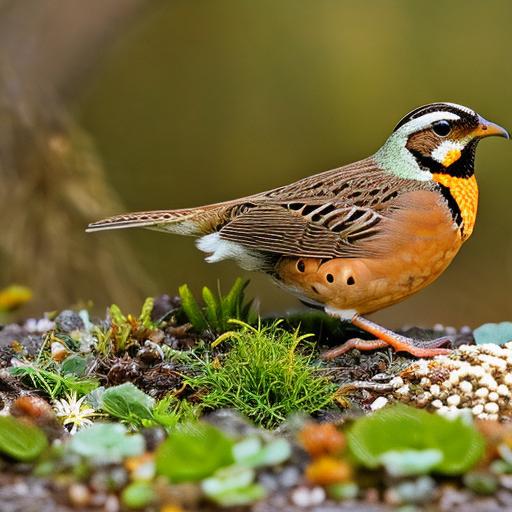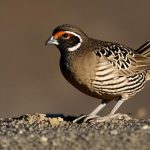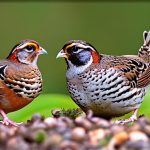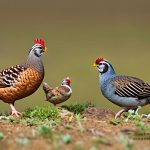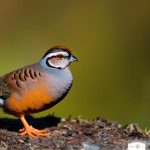Quail can pose a significant threat to gardens and landscaping due to their foraging behavior. These small ground-dwelling birds are known for their voracious appetites and can quickly decimate a garden by consuming newly planted seeds, tender shoots, and ripe fruits and vegetables. Additionally, quail are notorious for dust bathing, which can lead to soil erosion and damage to delicate plants. Their presence can also attract other pests, such as insects and rodents, further exacerbating the damage to the garden. It’s important for gardeners to understand the potential threat that quail pose in order to take proactive measures to protect their plants and landscaping.
Quail are also known for their prolific breeding habits, which can lead to rapidly increasing populations in a short amount of time. This can further intensify the damage they cause in the garden, as larger flocks of quail will require more food and can quickly strip a garden of its resources. Understanding the threat of quail in the garden involves recognizing their feeding and nesting habits, as well as their potential to attract other pests. By understanding these factors, gardeners can better prepare themselves to implement effective strategies for keeping quail out of their garden.
Key Takeaways
- Quail can pose a threat to gardens by eating plants and damaging crops.
- Creating physical barriers such as fences and netting can effectively keep quail out of the garden.
- Natural deterrents like predator decoys and strong-smelling plants can discourage quail from entering the garden.
- Scare tactics such as motion-activated sprinklers and noise-making devices can help keep quail away from the garden.
- Managing food sources by keeping bird feeders and fallen fruits cleaned up can reduce the attraction of quail to the garden.
- If quail problems persist, seeking professional help from pest control experts or wildlife management professionals may be necessary.
- By implementing a combination of strategies and staying proactive, it is possible to maintain a quail-free garden and protect plants and crops from damage.
Creating Physical Barriers to Keep Quail Out
One of the most effective ways to keep quail out of the garden is to create physical barriers that prevent their access. This can be achieved through the installation of fencing or netting around the perimeter of the garden. The fencing should be at least 2 feet high and buried several inches into the ground to prevent quail from burrowing underneath. Additionally, the mesh size should be small enough to prevent quail from squeezing through or getting caught in the openings. Netting can also be used to cover individual plants or rows of crops to protect them from quail damage.
Another option for creating physical barriers is the use of raised beds or containers for planting. By elevating the garden beds, it becomes more difficult for quail to access the plants and forage for food. This method also has the added benefit of improving drainage and reducing the risk of soil compaction, which can further protect the garden from quail damage. Creating physical barriers to keep quail out of the garden requires careful planning and implementation, but it can be an effective long-term solution for protecting plants and landscaping from these pesky birds.
Using Natural Deterrents to Discourage Quail
In addition to physical barriers, natural deterrents can also be used to discourage quail from entering the garden. One effective method is the use of predator decoys, such as plastic owls or snakes, which can create the illusion of danger and deter quail from foraging in the area. These decoys should be moved regularly to prevent quail from becoming accustomed to their presence. Another natural deterrent is the use of strong-smelling plants, such as lavender, rosemary, or marigolds, which can help repel quail with their pungent odors.
Furthermore, the use of noise deterrents, such as wind chimes or motion-activated devices, can startle quail and discourage them from entering the garden. These deterrents should be strategically placed around the garden to create a barrier of sound that makes quail feel uncomfortable and unsafe. Additionally, the use of reflective objects, such as aluminum foil strips or CDs hung from trees or stakes, can create visual disturbances that deter quail from entering the area. Using natural deterrents to discourage quail from entering the garden can be an effective and environmentally friendly way to protect plants and landscaping from their destructive behavior.
Implementing Scare Tactics to Keep Quail Away
Scare tactics can be an effective short-term solution for keeping quail away from the garden. One common scare tactic is the use of motion-activated sprinklers, which release a sudden burst of water when quail are detected in the area. This unexpected spray can startle quail and discourage them from returning to the garden. Another scare tactic is the use of noise-making devices, such as air horns or whistles, which can be activated when quail are spotted in the garden. These sudden loud noises can frighten quail and make them wary of returning to the area.
Additionally, the use of visual scare tactics, such as scarecrows or brightly colored flags, can create a sense of danger and deter quail from entering the garden. These visual deterrents should be moved regularly to prevent quail from becoming accustomed to their presence. Another effective scare tactic is the use of motion-activated lights, which can startle quail and make them feel unsafe in the garden. Implementing scare tactics to keep quail away from the garden requires consistent monitoring and maintenance, but it can be an effective way to protect plants and landscaping from their destructive behavior.
Managing Food Sources to Reduce Quail Attraction
Quail are attracted to gardens and landscaping because of the abundance of food sources available to them. By managing these food sources, gardeners can reduce the attraction of quail to their property. One effective method is to remove fallen fruits and vegetables from the ground, as these can serve as a food source for quail. Additionally, keeping bird feeders elevated and using feeders with squirrel guards can help prevent quail from accessing bird seed and other food sources intended for other wildlife.
Another way to manage food sources is by planting less attractive crops that are less appealing to quail. This can include plants with strong odors or prickly textures that deter quail from foraging in the area. Additionally, using row covers or cloches to protect vulnerable plants from quail damage can help reduce their access to food sources in the garden. Managing food sources to reduce quail attraction requires careful planning and maintenance, but it can be an effective long-term solution for protecting plants and landscaping from these pesky birds.
Seeking Professional Help for Persistent Quail Problems
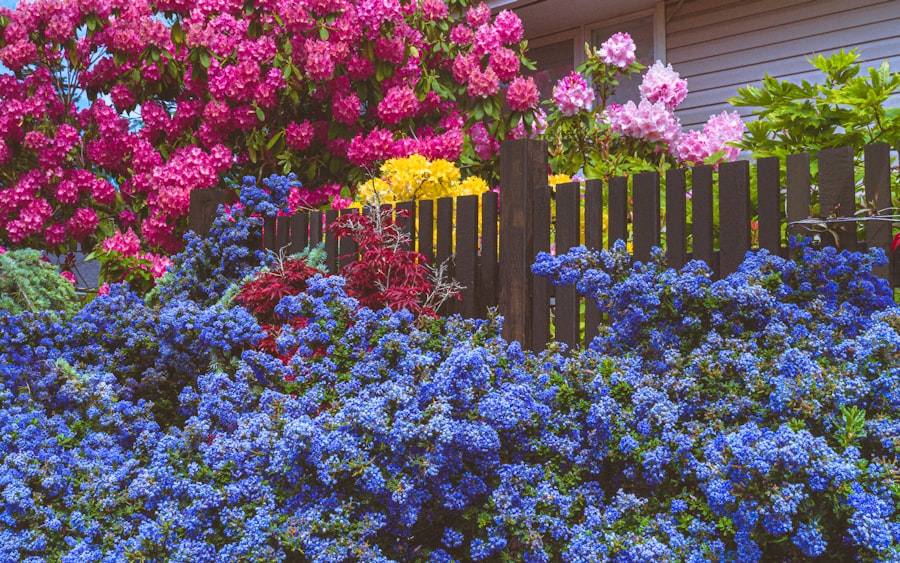
In some cases, persistent quail problems may require professional assistance to effectively manage and control their presence in the garden. Wildlife management professionals have the knowledge and experience to implement effective strategies for keeping quail away from residential properties. This may include the installation of exclusion fencing or netting, as well as the use of humane trapping and relocation methods to remove quail from the area.
Additionally, wildlife management professionals can provide valuable advice on habitat modification and landscaping techniques that can make properties less attractive to quail. This may include recommendations for planting less appealing crops or creating natural barriers that deter quail from entering the garden. Seeking professional help for persistent quail problems can provide homeowners with peace of mind and a long-term solution for protecting their plants and landscaping from these pesky birds.
Maintaining a Quail-Free Garden
In conclusion, understanding the threat of quail in the garden is essential for implementing effective strategies to keep them away from plants and landscaping. Creating physical barriers, using natural deterrents, implementing scare tactics, managing food sources, and seeking professional help are all viable options for maintaining a quail-free garden. By taking proactive measures to protect their property, homeowners can enjoy a beautiful and bountiful garden without the threat of damage from these pesky birds. With careful planning and consistent maintenance, it is possible to create a welcoming environment for plants and wildlife while keeping quail at bay.
If you’re looking for ways to keep quail out of your garden, you might also be interested in learning about the best flooring options for a chicken coop. Check out this informative article on choosing the right floor for your chicken coop to ensure a comfortable and clean environment for your feathered friends.
FAQs
What are some effective methods to keep quail out of the garden?
Some effective methods to keep quail out of the garden include using physical barriers such as fences or netting, using scare tactics such as motion-activated devices or reflective materials, and removing food sources that attract quail to the garden.
What type of fencing is best for keeping quail out of the garden?
A small-mesh wire fencing, such as chicken wire or hardware cloth, is best for keeping quail out of the garden. The fencing should be at least 3 feet high and buried a few inches into the ground to prevent quail from digging underneath.
What are some scare tactics that can be used to deter quail from the garden?
Scare tactics such as motion-activated sprinklers, predator decoys, and reflective materials like aluminum foil or old CDs can be effective in deterring quail from the garden. These tactics startle the quail and make them less likely to return to the area.
How can I remove food sources that attract quail to the garden?
To remove food sources that attract quail to the garden, avoid leaving birdseed or other grains exposed, clean up fallen fruits and vegetables, and use bird feeders that are designed to prevent spillage. Additionally, consider planting less attractive plants for quail or using repellents to discourage them from feeding in the garden.
Meet Walter, the feathered-friend fanatic of Florida! Nestled in the sunshine state, Walter struts through life with his feathered companions, clucking his way to happiness. With a coop that’s fancier than a five-star hotel, he’s the Don Juan of the chicken world. When he’s not teaching his hens to do the cha-cha, you’ll find him in a heated debate with his prized rooster, Sir Clucks-a-Lot. Walter’s poultry passion is no yolk; he’s the sunny-side-up guy you never knew you needed in your flock of friends!

